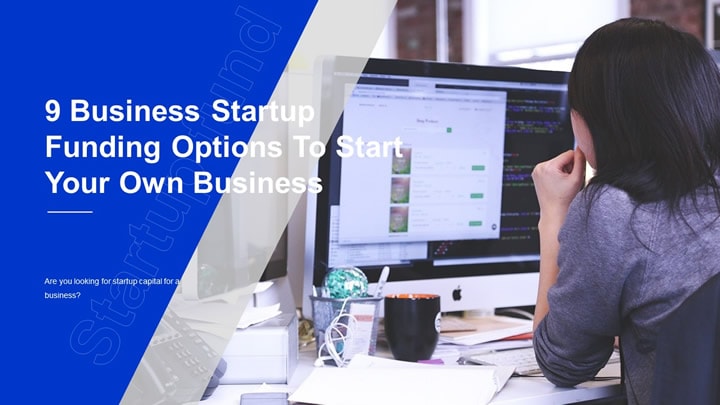PDFelement-Powerful and Simple PDF Editor
Get started with the easiest way to manage PDFs with PDFelement!
Most small businesses are conceived of a unique idea that seeks to meet a consumer need or solve a pressing problem. That said, no matter how ingenious a business idea may be, the growth and success of a startup depend highly on its ability to obtain sufficient funding to get it off the ground and ensure its scalability. And that is where startup business financing enters the stage.
A PDF editor can help you easily handle financial forms in PDF format. Learn how to edit, fill and sign PDF forms with the best PDF solution for small businesses.

In this article
Preparations for Startup Seed Funding
As a startup, your business requires capital investment to firm its base and also aid its expansion. A huge part of making that happen is sourcing funding options for your business. You have a better shot at funding success when you have put your house in order. Here are some ways to prepare for startup seed funding.
1. Plan Ahead
An effective startup business funding initiative starts with a solid plan. Funding options are not always knocking at your door, and you may need to plan your business to make it eligible for funding months before you start sourcing funds.
Planning looks like creating a business plan that will appeal to potential investors. You should also begin identifying people and organizations keen to fund your business idea. An online search for startup funding options is an excellent place to learn how to prime your business for investors and also identify potential ones.
2. Determine Your Source of Financing
Once your business plan is set, the next course of action is to determine your source of financing. Identify capable people and organizations you can pitch your business idea to get startup business financing assistance. Angel investors can be resourceful sources of funding. Government grants and friends and family are also great alternatives.
3. Research Your Investors
You have your list of potential investors. The next step is to get down to identifying what they want to see from a startup funding pitch. Some investors will need to see your burn rate and cash projections.
Research helps you understand the expectations investors have of businesses they are willing to offer funding aid. A little research also makes you aware of common lingo and crucial metrics investors expect you to be conversant with to trust your business with their money.
4. Prepare Your Startup Funding Proposal
You have your list of potential investors and have done proper research on their expectations. What is left is approaching them with your business idea. The manner in which you approach them and present your business plays a significant role in determining if they will be convinced to put their financial weight behind your startup venture. Your pitch and proposal should paint your business in glowing light to give potential investors all reasons to put their money into it.

Show that your business idea has immense market potential and is the greatest thing since sliced bread. That way, they will not hesitate to join the ride. See, investors encounter hundreds, if not more, proposals every month.
Yours needs to stand out from the sea. One way to make it exceptional is to structure it in the best format. Use tools like Wondershare PDFelement - PDF Editor to edit PDF, and convert Word, Excel, and other file formats to compelling PDF proposals. It will make it easier for you to prepare professional-looking documents that are easy to share.

Want to learn more useful features of PDFelement to edit a business proposal? Watch the video below:
Furthermore, PDFelement offers beautiful business proposal covers in its Template Mall. You can download a desired one to make your proposal look appealing.
9 Options To Get Business Funding for Startups
Financing options for startups are a dime a dozen. However, what works for one business may not cut it for the next. The choice of financing options depends on the nature of the business, its age, market opportunities, and its performance. Here are some of the options to consider when diversifying your sources of financing:
Option 1. Startup Business Loans Online
The online space has been instrumental in many sectors. One way it comes through for startups is by offering financing options.
Fintech companies have been mushrooming, and it is not unusual to find online lenders willing to extend business loans. Online startup business loans are a prime option for startups that do not mind the traditional loan experience but would rather not go through the hassle of going to a bank branch.
Advantages
Flexible repayment options.
Increasing loan limit.
Unsecured, hence no need for the collateral property.
Faster approval process compared to bank loans.
Disadvantages
Higher interest rates.
Risk of hacking and scams.
Low maximum limit on loans, especially for first-timers.
Option 2. Self-Funding To Start a Business
Self-funding or bootstrapping is another way to go. Here, Startup business owners use their financial resources to start and support their businesses. A business owner could tap into their 401(k) or dig into their savings account to run the business.
Advantages
Startup owners can retain control over the business.
Startup owner enjoys all the profits from the success of the business.
Disadvantages
All the risk falls on the startup owner.
Taping into retirement may ruin the ability to retire on time.
Startup owner has to deal with substantial debt if the business does not succeed.
Limited resources.
Option 3. Love Money To Fund a Startup
Love money is money that parents, family members, and spouses may offer a startup owner to inject into their business. In this setup, investors may expect repayment once business profits pick up.
Advantages
Lower interest rates.
Flexible even for entrepreneurs with poor credit.
Disadvantages
Friends and family may expect to have equity in the business.
This option does not raise as much capital.
It can put family and friend relationships in jeopardy.
The lack of legal documentation makes it lack clarity.
Option 4. Startup Venture Capital
With startup venture capital, the investors gain equity over a high-growth potential business to help it during high-risk projects. Venture capitalists are most interested in tech-based businesses, like biotechnology, information technology, and communications. This financing option works for business owners that do not mind giving up part ownership of their business to an external party. When choosing a venture capitalist, it is best to look for those with relevant knowledge and experience to take your startup to the next level.
Advantages
Can contribute to more growth.
It provides an opportunity to connect with other business leaders.
The risk of business failure is distributed among the investors.
Disadvantages
Investors own a stake in the business.
Raising funds can be arduous.

Option 5. Government Grants Startup Funding for Small Business
Grants are cash awards to deserving startup businesses to help them begin or scale operations. Grants can come from the state and local government or corporate organizations.
Advantages
Grants do not require repayment.
Information on grants is readily available.
Receiving grants increases visibility for startups.
Disadvantages
Loans can be reserved for specific businesses, e.g., businesses owned by minorities, veterans, women, etc.
They are extremely competitive and in short supply.
Renewal is uncertain.
Grants can have plenty of restrictions and conditions.
Option 6. Business Line of Credit To Fund a Startup
Business lines of credit are an unsecured financing option where startup founders can access funds up to a borrowing limit. The business can get money from the maximum balance when they need it. Interest on business lines of credit accrues on the amount the startup business gets. The business owner will pay a minimum payment depending on the current balance on the loan.
Advantages
More accessible eligibility, making it perfect for handling cash flow issues and business costs.
A small business will only for what they need.
Provides an opportunity to build lasting relationships with lenders.
Disadvantages
Borrowing limits are lower compared to term loans.
The application process can be time-consuming.
Interest rates can be high.
Option 7. Invoice Funding to Start a Small Business
With invoice funding, the money startup owners borrow is secured by the value of unpaid invoices. Invoice Financing differs from invoice factoring in that, with invoice financing, the startup business collects customer payments for underlying invoices to repay the loan. Hounding customers for payment is not the responsibility of the lending company.
Advantages
It works great for businesses without established credit.
Invoice funding provides better cash flow and a faster working capital cycle.
Invoice financing offers credit control help.
Disadvantages
With invoice financing, other businesses have to be your clients.
There are decreased profits due to loan processing fees.
Risky since debtors could fail to pay overdue invoices.
Funding depends on current accounts receivables and may not be enough if a startup needs more money.
Option 8. Business Incubators or Accelerators to Fund a Startup
Business incubators, also known as accelerators, provide financial support for businesses in different developmental stages. That said, local economic development incubators may focus on other aspects like job creation and revitalization.
Usually, incubators may offer support by allowing startup businesses to use their premises, technical and logistical resources and administrative facilities. That goes a long way in minimizing the costs a startup business has to incur in developing its products.
Businesses will occupy the incubator space for a limited period (could be up to 2 years), after which they then enter other production phases independently.
Advantages
Incubators offer business development programs like panel discussions and workshops.
They give startups access to must-haves like production equipment and administrative support, reducing overhead.
Incubator environment and curriculum drives focus for startups.
Disadvantages
Competitive and rigorous application process.
Adhering to the incubator schedules can be tedious.
The startup owner is answerable to someone.
Option 9. SBA Loans
Small Business Administration (SBA) loan programs offer startup business owners who need money to start or grow their businesses. The federal government is usually behind these loans, and the terms can go up to six years. SBA programs use approved lenders to offer support to small business owners.
Advantages
Great for startups that do not qualify for traditional loans.
SBAs offer better credit flexibility compared to bank loans.
Fixed maximum interest loans.
They offer long repayment terms.
Disadvantages
The application and approval process can be extensive and competitive.
SBAs may require down payments.
Interest rates and terms are less competitive compared to other bank loans.
Conclusion
It is common for businesses to need financing at some point in their lifetime. Funding is even more essential for startups that have to bear startup costs and find avenues to grow into successful ventures. There are numerous funding options, some posing higher risks than others. A look into the different options and the pros and cons of each is a great place to start when choosing the best funding option for your startup business.



